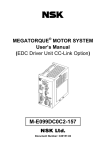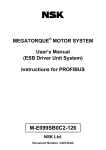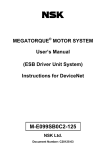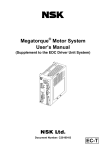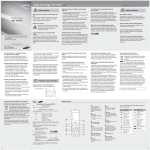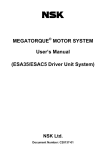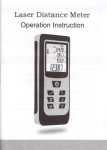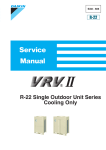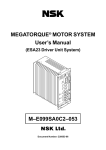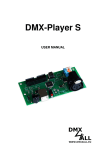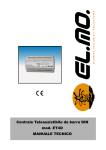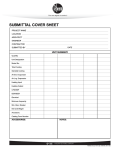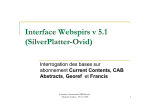Download M-E099SB0C2-132
Transcript
MEGATORQUE® MOTOR SYSTEM User’s Manual ESB Driver Unit System Compatible With CC-Link M-E099SB0C2-132 Document Number: C20132-02 Limited Warranty NSK Ltd. warrants its products to be free from defects in material and/or workmanship which NSK Ltd. is notified of in writing within, which comes first, one (1) year of shipment or 2400 total operation hours. NSK Ltd., at its option, and with transportation charges prepaid by the claimant, will repair or replace any product which has been proved to the satisfaction of NSK Ltd. to have a defect in material and/or workmanship. This warranty is the sole and exclusive remedy available, and under no circumstances shall NSK Ltd. be liable for any consequential damages, loss of profits and/or personal injury as a result of claim arising under this limited warranty. NSK Ltd. makes no other warranty express or implied, and disclaims any warranties for fitness for a particular purpose or merchantability. Copyright 2003 by NSK Ltd., Tokyo, Japan All rights reserved. No part of this publication may be reproduced in any form or by any means without permission in writing from NSK Ltd. NSK Ltd. reserves the right to make changes to any products herein to improve reliability, function or design without prior notice and without any obligation. NSK Ltd. does not assume any liability arising out of the application or use of any product described herein; neither does it convey any license under its present patent nor the rights of others. Patents issued and patents pending. “MEGATORQUE” is a registered trademark of NSK Ltd. in Japan and that of NSK Corp. in the United States of America. Introduction ¡ About This Manual l This manual describes the interface of CC-Link. For the other part of the Megatorque Motor System, please refer to the user’s manual of Megatorque Motor System (ESB Driver Unit System [Document Number: C20118-01]). ¡ Notice for Your Safety l Please read this manual thoroughly and take necessary precaution for your safety. ¡ Restriction on Function of the Driver Unit l The following functions are not available for the Driver Unit compatible with the CC-Link. à Velocity control mode and torque control mode à Pulse train positioning command à Positioning with acceleration profiling —i— (Blank Page) — ii — Contents 1. Specifications---------------------------------------------------------- 1-1 1.1. Specificaitons of CC-Link Station -------------------------------------------------1-1 1.2. Driver Unit Dimensions --------------------------------------------------------------1-1 1.3. Signal specifications for Control Input and Output ----------------------------1-2 1.4. Setup of I/O by Operation Mode --------------------------------------------------1-3 1.4.1. I/O Setup for CC-Link or Maintenance Mode ----------------------------1-3 2. Specifications of External Interface ------------------------------ 2-1 2.1. CN2 Connector ------------------------------------------------------------------------2-1 2.1.1. CN2 Pin-Out ---------------------------------------------------------------------2-1 2.1.2. CN2 Signal Name and Function --------------------------------------------2-2 2.2. Specifications for CC-Link ----------------------------------------------------------2-3 2.2.1. CN5 (CC-Link) Cponnector --------------------------------------------------2-3 2.2.2. CN5 (CC-Link) Pin-Out--------------------------------------------------------2-3 2.2.3. CN5 Signal Name and Function --------------------------------------------2-3 2.2.4. Setting of SW1 and SW2 (Set Station Number)-------------------------2-4 2.2.5. Setting of SW3 (Setting of Baud Rate) ------------------------------------2-4 2.2.6. Setting of SW4 (Terminating Resister) ------------------------------------2.4 2.2.7. Indication of LED ---------------------------------------------------------------2-5 2.2.8. Example of External Wiring --------------------------------------------------2-6 2.2.9. Cable Length and Specification of Communication --------------------2-7 3. Layout of Remote Input/Output ----------------------------------- 3-1 3.1. Remote I/O -----------------------------------------------------------------------------3-1 3.2. Remote Registor ----------------------------------------------------------------------3-2 4. Description of Remote Input/Output ----------------------------- 4-1 4.1. Input Signal (Master Unit to Remote Station ) ---------------------------------4-1 4.1.1. Emergency Stop Input (EMST)----------------------------------------------4-1 4.1.2. servo ON Input (SVON) -------------------------------------------------------4-1 4.1.3. Programmable Indexer Start Input (RUN) --------------------------------4-1 4.1.4. Home Return Start Input (HOS) -------------------------------------------4-1 4.1.5. Clear Input for Position Error Counter and Alarm (CLR) --------------4-2 4.1.6. Input for Integrator OFF / Lower Gain (IOFF)----------------------------4-2 4.1.7. Clamp Cancel Input (CLCN) -------------------------------------------------4-2 4.1.8. Jog Input (JOG) -----------------------------------------------------------------4-3 4.1.9. Direction Select Input (DIR) --------------------------------------------------4-3 4.1.10 Input for Internal Program Channel Select (PRGx: x= 0 to 5) -----4-3 4.1.11. Velocity Override Input (ORD) --------------------------------------------4-4 4.1.12. Stop Input (STP) --------------------------------------------------------------4-4 —i— 4.2. Output Signal (Remote Station to Master Unit) --------------------------------4-5 4.2.1. Output for Driver Unit Ready (DRDY) / Warning (OVER) -------------4-5 4.2.2. In-position Output (IPOS)-----------------------------------------------------4-6 4.2.3. Output for Processing Internal Pulse (BUSY) --------------------------4-6 4.2.4. Home Position Defined (HCMP) --------------------------------------------4-6 4.2.5. Brake Output (BRK)------------------------------------------------------------4-6 4.2.6. Brake Control Output (BRKC) -----------------------------------------------4-6 4.2.7. Output of Target Proximity / In target (NEARA and NEARB) -------4-7 4.2.8. Output of Selected Channel Number (ACK_PRGx x = 0 to 5.) ------4-8 4.2.9. Velocity Monitor Output (SPD) -------------------------------------------- 4-10 4.2.10. Output of Home Return Completed / Home Position Detected (HOME) ------------------------------------- 4-10 5. Turning on Power ---------------------------------------------------- 5-1 5.1. Operation Mode -----------------------------------------------------------------------5-2 5.1.1. CC-Link Mode ------------------------------------------------------------------5-2 5.1.2. Maintenance Mode -----------------------------------------------------------5-3 5.1.3. Switching Operation Mode ---------------------------------------------------5-3 5.1.3.1. Switch to Maintenance Mode from CC-Link mode ---------------5-3 5.1.3.2. Switch to CC-Link Mode from Maintenance Mode ---------------5-3 6. Additional Functions ------------------------------------------------ 6-1 6.1. Velocity Override----------------------------------------------------------------------6-1 7. Additional Commands for RS-232C Communication ------ 7-1 7.1.List of Additional Functions --------------------------------------------------------7-1 8. Alarms Related to CC-Link --------------------------------------- 8-1 8.1. CC-Link Error --------------------------------------------------------------------------8-1 8.2. CC-Link Setting Switch Error-------------------------------------------------------8-2 — ii — 1. Specifications 1.1. Specifications of CC-Link Station l ESB Driver Unit is compatible with [CC-Link Ver.1.10]. l ESB Driver Unit that is compatible with CC-Link is an exclusive remote device that connects to the CC-Link and can be controlled by a master unit such as a sequencer. Figure 1-1 Table 1-1 Station category Remote device station Number of exclusive station 1 1.2. Driver Unit Dimensions Figure 1-2 — 1-1 — 1.3. Signal Specifications of Control Input and Output Table 1-2 Input Signal Output signal · In case of CC-Link operation mode; Emergency stop, Home limit switch, Over travel limit switch (CW, CCW) · In case of maintenance operation mode; Emergency stop, Servo on, Home Return start, Clear, Integrator OFF/Lower gain, Clamp Cancel*1, Home limit switch, Over travel limit switch (CW, CCW) CC-Link · In case of CC-Link operation mode; (CN5) Emergency stop, Servo-on, Programmable Indexer start, Home Return start, Clear, Integrator OFF/Lower gain, Clamp Cancel*1, Jog, Direction select, Internal program channel select, Velocity override, Stop *Emergency stop is logical sum of CN2 and CN5. When operation is in the maintenance mode, all inputs of CC-Link are invalid. Position feed back Refer to “Specification of Motor resolver resolution in ESB Megatorque signal Motor System Specification Sheet.” Control CN2 Driver Unit ready, In-position, Brake/Brake control*1 output CC-Link · In case of CC-Link operation mode; (CN5) Driver Unit ready, In-position, Processing internal pulses, Home position defined, Warning, Brake/Brake control*1, Target proximity/ In target A, Target proximity/In target B, Selected channel number, Monitor velocity, Home Return completed/Home position detected · In case of maintenance operation mode; Driver Unit ready, In-position, Processing internal pulses, Home position defined, Warning, Brake/Brake control*1, Target proximity/ In target A, Target proximity/In target B, Monitor velocity, Home Return completed/Home position detected Control input CN2 *1: When using motor with brake combined with brake sequence function(BF1), signals Integrator off / Low gain will be used as Clamp cancel input, Brake output will be used as Brake control output. l You may switch the operation mode by a mode switch command (CP) through the Handy Terminal. Refer to the description of CP command for more details. l CC-Link mode is to operate the Drive Unit by control input signal through CC-Link. l Maintenance mode is to operate the Driver Unit temporarily when CC-Link is not available for some reason. l CC-Link mode is set as the initial setting right after the power of the Driver Unit is turned on. — 1-2 — 1.4. Setup of I/O by Operation Mode Switching the operation mode changes the validity of I/O signals of CC-Link and CN2 connector. [Switching command of operation mode (CP) switches the operation mode.] 1.4.1. I/O Setup for CC-Link or Maintenance Mode Table 1-3 Input/ Output Input Output Signal name EMST SVON RUN HOS CLR IOFF /CLCN*1 JOG DIR PRG0 PRG1 PRG2 PRG3 PRG4 PRG5 ORD HLS OTM OTP STP DRDY IPOS BUSY HCMP OVER BRK/BRKC*1 NEARA NEARB ACK_PRG0 ACK_PRG1 ACK_PRG2 ACK_PRG3 ACK_PRG4 ACK_PRG5 SPD HOME CC-Link mode CC-Link CN2 Valid Valid Valid Invalid Valid – Valid Invalid Valid Invalid Valid Invalid Valid – Valid – Valid – Valid – Valid – Valid – Valid – Valid – Valid – – Valid – Valid – Valid Valid – Valid Valid Valid Valid Valid – Valid – Valid – Valid Valid Valid – Valid – Valid – Valid – Valid – Valid – Valid – Valid – Valid – Valid – Maintenance mode CC-Link CN2 Invalid Valid Invalid Valid Invalid – Invalid Valid Invalid Valid Invalid Valid Invalid – Invalid – Invalid – Invalid – Invalid – Invalid – Invalid – Invalid – Invalid – – Valid – Valid – Valid Invalid – Valid Valid Valid Valid Valid – Valid – Valid – Valid Valid Valid – Valid – Invalid – Invalid – Invalid – Invalid – Invalid – Invalid – Valid – Valid – *1: When using motor with brake combined with brake sequence function(BF1), signals Integrator off / Low gain will be used as Clamp cancel input, Brake output will be used as Brake control output. — 1-3 — (Blank page) — 1-4 — 2. Specifications of External Interface 2.1. CN2 Connector 2.1.1. CN2 Pin-Out Figure 2-1 25 *1 (IOFF/CLCN ) 24 (HOS) 23 OTM 22 – 21 – 20 *CHA 19 *CHB 18 CHZ 17 SGND 16 DRDY+ 15 IPOS 14 (SVON) 13 12 11 10 9 8 7 6 5 4 3 2 1 DC24V EMST HLS (CLR) OTP – – CHA CHB *CHZ BRK/BRKC *1 DRDYCOM l Signals SVON, CLR, IOFF/CLCN*1 and HOS, which are put in parentheses, are not valid in CC-Link mode. *1: When using motor with brake combined with brake sequence function(BF1), signals Integrator off / Low gain will be used as Clamp cancel input, Brake output will be used as Brake control output. — 2-1 — 2.1.2. CN2 Signal Name and Function Table 2-1 Pin No. 1 2 3 4 5 6 7 8 9 10 11 12 13 14 15 16 17 18 19 20 21 22 23 24 25 Signal name COM DRDYBRK/BRKC*1 *CHZ*1 CHB CHA – – OTP (CLR) *2 HLS EMST DC24 IPOS DRDY+ SGND CHZ*1 *CHB *CHA – – OTM (HOS) *2 (IOFF/CLCN*3) *2 (SVON) *2 I/O O O O O O O I I I I I I I O O – O O O I I I I I I Function Output COMMON Driver Unit ready (–) Brake /Brake control signal (normally close) Position feedback signal *øZ/Digital position data *MSB*1 Position feedback signal øB Position feedback signal øA Do not connect. Do not connect. + direction over travel limit switch (CW direction) Clear input Home limit switch Emergency stop DC 24V external power supply In-position Driver Unit ready (+) Signal ground Feedback position signal øZ/Digital position signal MSB*1 Position feedback signal *øB Position feedback signal *øA Do not connect. Do not connect. – direction over travel limit switch (CCW direction) Home Return start Integrator OFF /Clamp cansel Servo on *1: FZ parameter (RS-232C communication) is used to set the function either position feedback signal øZ/ or digital position signal MSB. *2: Signals SVON, CLR, IOFF and HOS, which are put in the parentheses, are not valid in CC-Link mode. *3: When using motor with brake combined with brake sequence function(BF1), signals Integrator off / Low gain will be used as Clamp cancel input, Brake output will be used as Brake control output. — 2-2 — 2.2. Specifications for CC-Link Figure 2-2 CC-Link CN5 : CC-Link connector SW1 : Sets station number. CN5 (Position of 10s) SW2 : Sets station number. (Position of 1s) SW3 : Sets baud rate. SW4 : Sets terminating resistance. SW4 LED : Indicates status. (RUN/ERR/RD/SD) SW1 SW2 SW3 LED 2.2.1. CN5 (CC-Link) Connector Table 2-2 Driver Unit Connector Mating connector type (User device side) Phoenix Contact MSTBA2,5/4-G-5,08AU MSTB2,5/4-ST-5,08AU * These connectors will be provided with the Driver Unit. 2.2.2. CN5 (CC-Link) Pin-Out Figure 2-3 1. DA 2. DB 3. DG 4. SLD 2.2.3. CN5 Signal Name and Function Table 2-3 Pin 1 2 3 4 Signal DA DB DG SLD I/O I/O I/O – – Function Data A Data B Data ground Shield — 2-3 — 2.2.4. Setting of SW1 and SW2 (Set Station Number.) l Station number = (Setting of SW1; position of 10s) + (Setting of SW2; position of 1s) * Do not set station number to 0 or 65 and over. Table 2-4 SW1 setting 0 0 0 0 • • • 1 1 • • • 6 SW2 setting 1 2 3 4 • • • 0 1 • • • 4 Station number 01 02 03 04 • • • 10 11 • • • 64 2.2.5. Setting of SW3 (Setting Baud Rate) Table 2-5 SW3 setting 0 1 2 3 4 5~9 Baud rate 156Kbps 625Kbps 2.5Mbps 5Mbps 10Mbps Do not set. 2.2.6. Setting of SW4 (Terminating Resistance) Figure 2-4 Sets to 110W. No terminating resistance Sets to 130W. Upside of the Driver Unit Table 2-6 SW4 setting Top Center Bottom Function of terminating resistance Sets to 110W. Sets no terminating resistance. Sets to 130W. — 2-4 — 2.2.7. Indication of LED Figure 2-5 ERR RUN RD SD Upside of the Driver Unit Table 2-7 Name of LED RUN ERR SD RD Status ON: Receiving refresh and polling normally after joining the network, or normal communication of refresh. OFF: (1) Before joining the network. (2) NG on detecting the carrier on the channel 1 and 2. (3) Time over. (4) Resetting hardware. ON: (1) CRC error. (2) Abnormal SW setting of station number. (3) Abnormal SW setting of baud rate OFF: (1) Communication is normal. (2) Resetting hardware. Blinking: Settings of SW1 and SW2 have changed after the power was turned on. ON: Transmitting data. OFF: (1) In a state other than transmitting data. (2) Resetting hardware. ON: Detecting a carrier of channel 1 or channel 2. OFF: (1) Detection of carrier of both channel 1and channel 2 are not successful. (2) In the middle of resetting hardware. Table 2-8 RUN ERR SD On Off Blink On Blink Blink On Blink* Blink On Blink Off On Off Off Off Blink Blink On Blink Off Off Off Blink Off Off Off Off Off Off Off On Off RD Status Normal communication On CRC error occurs occasionally even in normal communication. On Baud rate and station number setting have changed from those settings at the moment of power on. On *Blinking cycle of ERR is 0.4s. ESB Driver Unit cannot respond because the receiving data becomes On CRC error. The data does not reach to the Driver Unit. On Responding to polling, however receiving refresh is CRC error. On CRC error occurs on the data to the Diver Unit. On The link is not started. On There is no data to the Driver Unit, or it is not ready for receiving the On data. Impossible to receive the data. The power is turned off or resetting the Off hardware. On/Off Incorrect setting of Baud rate or station number. l Blinking cycle of SD is so fast that the LED may seem to be ON. — 2-5 — 2.2.8. Example of External Wiring Figure 2-6 Master station Terminating resistance Remote station (ESB Driver Unit) Local station DA DA DA DB DB DB DG DG DG SLD FG CC-Link cable SLD FG CC-Link cable SLD FG Terminating resistance If ESB Driver Unit is the end unit of the network, SW4 functions as the terminating resistance. l Use the cables unique to CC-Link for connecting cables. l Order of the station number does not need to match the order of installation to the network. l Connect the terminating resistance to “DA – DB” units on the both ends of the network. (The terminating resister can be set by SW4 of the ESB Driver Unit.) l There is not “FG” terminal for CN5 connector of ESB Driver Unit. Be sure to ground “FGND” terminal of the Terminal TB. — 2-6 — 2.2.9. Cable Length and Specification of Communication Table 2-9:Specification of cable unique use of CC-Link (Characteristic inpedance110 W) Version Baud rate 156 Kbps 625 Kbps 2.5 Mbps 5 Mbps 10 Mbps Terminating resistance Remarks CC-Link Ver.1.10 Cable length between stations Maximum overall length of cable *1, *2, *3 1200 m 900 m 0.2 m or over 400 m 160 m 100m 110 W (between DA – DB) May be mixed with the cable compatible with CC-Link Ver.1.10. Figure2-7: System only consists of remote I/O station and remote device station Max. overall cable length Terminating resistance Remote device station Master station *1 *2 *2 *1 Remote device station Remote device station *1 Remote device station Terminating resistance *1 Remote I/O station Remote I/O station *1: Cable length between the stations of remote I/O stations or remote device stations. *2: Cable length between the master station and a station. Figure 2-8: System includes local stations or intelligent device station Max. cable overall length Terminating resistance Remote device station Master station *1 *2 Remote device station *2 *1 Remote device station *3 Remote device station *3 Local statoin *1: Cable length between remote I/O stations or remote device stations. *2: Cable length between a station and the master station. *3: Cable length between local stations or intelligent device station. — 2-7 — Terminating resistance Local station (Blank page) — 2-8 — 3. Layout of Remote I/O and Remote Register 3.1. Remote I/O Table 3-1 Device No. RXm0 RXm1 RXm2 RXm3 RXm4 RXm5 RXm6 RXm7 RXm8 RXm9 RXmA RXmB RXmC RXmD RXmE RXmF RX (m+1) 0 RX (m+1) 1 RX (m+1) 2 RX (m+1) 3 RX (m+1) 4 RX (m+1) 5 RX (m+1) 6 RX (m+1) 7 RX (m+1) 8 RX (m+1) 9 RX (m+1) A RX (m+1) B RX (m+1) C RX (m+1) D RX (m+1) E RX (m+1) F Remote ® Master Signal name DRDY (Driver Unit ready) IPOS (In position) BUSY (Processing internal pulse) HCMP (Home position defined) OVER (Status of warning.) BRK/BRKC*3 (Brake /Brake control signal) NEARA (Target proximity/In-target A) NEARB (Target proximity/In-target B) ACK_PRG0 (Selected channel number) ACK_PRG1 (Selected channel number)) ACK_PRG2 (Selected channel number) ACK_PRG3 (Selected channel number) ACK_PRG4 (Selected channel number) ACK_PRG5 (Selected channel number) STD (Monitor velocity) HOME (Home Return completed/Home position detected) System area Reserved (Specify the area of each machine) Flag to request initial processing*1 Flag for completion of initial setting*1 Error status flag*1 Remote station ready *2 Reserved Reserved Reserved Reserved RYm6 RYm7 RYm8 RYm9 RYmA RYmB RYmC RYmD RYmE Master ® Remote Signal Name EMST (Input, Emergency stop) SVON (Input. Servo on) RUN (Programmable Indexer start) HOS (Start Home Return) CLR (Input, Clear) IOFF/CLCN*3 (Integrator OFF/Lower gain, Clamp cancel) JOG (Jog) DIR (Jog direction select) PRG0 (Internal program channel select) PRG1 (Internal program channel select) PRG2 (Internal program channel select) PRG3 (Internal program channel select) PRG4 (Internal program channel select) PRG5 (Internal program channel select) ORD (Velocity override) RYmF STP (Stop) Device No. RYm0 RYm1 RYm2 RYm3 RYm4 RYm5 RY (m+1) 0 RY (m+1) 1 RY (m+1) 2 RY (m+1) 3 RY (m+1) 4 RY (m+1) 5 RY (m+1) 6 RY (m+1) 7 RY (m+1) 8 RY (m+1) 9 RY (m+1) A RY (m+1) B RY (m+1) C RY (m+1) D RY (m+1) E RY (m+1) F System area Reserved (Specify the area of each machine) Flag for completion of initial processing*1 Flag to request initial setting*1 Flag to request error reset. *1 Reserved. Reserved. Reserved Reserved Reserved m: It indicates a register number led by the first station number. *1 : Not used. *2 : Ready is outputted after the power is turned on. *3 : When using motor with brake combined with brake sequence function(BF1), signals Integrator off / Low gain will be used as Clamp cancel input, Brake output will be used as Brake control output. — 3-1 — 3.2. Remote Register Table3-2 Address RWwm+0 RWwm+1 RWwm+2 RWwm+3 Master ® Remote Description Reserved (For future extension) Reserved (For future extension) Reserved (For future extension) Reserved (For future extension) Table 3-3 Address RWrm+0 RWrm+1 RWrm+2 RWrm+3 Remote ® Master Description Reserved (For future extension) Reserved (For future extension) Reserved (For future extension) Reserved (For future extension) — 3-2 — 4. Description of Remote Input/Output 4.1. Input Signal (Master Unit to Remote Station) 4.1.1. Emergency Stop Input (EMST) l The Driver Unit detects the signal level of the input. l When EMST input is set to 1, the Driver Unit terminates the function of position loop control and the system stops in servo-lock state in the position loop control. l EMST input of CN2 connector is valid in the CC-Link mode. Table 4-1 EMST 0 1 Function Clears EMST input. Emergency stop is on. 4.1.2. Servo ON Input (SVON) l This input is to put the Motor in Servo-on state. l The Driver Unit detects the signal level of the input. l After the power is turned on and DRDY output changes to 1, the Motor gets in servo ON state when the SVON input is set to 1. Table 4-2 SVON 0 1 Function Servo OFF Servo ON 4.1.3. Programmable Indexer Start Input (RUN) l This input starts positioning of internal program of the channel specified by PRG0 ~ PRG5 inputs. l The Driver Unit detects the rising edge(0®1) of the input. 4.1.4. Home Return Start Input (HOS) l This input starts Home Return operation. l The Driver Unit detects the rising edge(0®1) of the input. — 4-1 — 4.1.5. Clear Input for Position Error Counter and Alarm (CLR) l The Driver Unit detects the rising edge(0®1) of the input. l Setting CLR input to 1 clears the position error counter. However, the system does not clear the position error counter in the middle of following operations. à Operation by the positioning command. à Programmed operation à Home Return à Jog l When an alarm for excessive position error occurs, setting the CLR signal to 1 will clear the position error counter and call off the alarm. l Alarms for software thermal, program error, RS-232C communication error and auto-tuning error will be cleared by inputting 1 of the CLR signal as well. 4.1.6. Input for Integrator OFF / Lower Gain (IOFF) *When brake sequence function is invalid l The Driver Unit detects the signal level of the input. l Integration control (VI) is invalidated when IOFF input is set to 1. Proportional gain of velocity loop (VG) is lowered to a value multiplied by the parameter LG (lowering ratio of velocity loop proportional gain). l When IOFF input is set to 1, parameter IM (selecting IOFF function) sets the input to function only for disabling integration OFF function or only for lowering velocity loop proportional gain. l This input is to control torque generation when the Motor equipped with brake is in holding position state. Table 4-3 IOFF 0 1 Function Integration ON・Lower gain not valid. IM0: Integration OFF and Lower gain (shipping set) IM1: Integration OFF IM2: Lower gain 4.1.7. Clamp cancel Input (CLCN) *When brake sequence function is valid l Select brake clamp function valid or invalid. l If CLCN input is 1, brake will be released, and no further brake clamp will be performed. However, if an alarm (which will make motor condition servo-off) occurs, brake will clamp. l If CLCN input is 0, brake will clamp/unclamp depending on the motor motion command. Table 4-4 CLCN 0 1 Function Brake clamp function valid Clamp cancel — 4-2 — 4.1.8. Jog Input (JOG) l This signal starts and stops the jog operation. l The Driver Unit detects the rising edge of the input. Table 4-5 JOG (0 ® 1) ¯ (1 ® 0) Function Starts JOG (Starts acceleration) Stops JOG (Decelerates and stops) 4.1.9. Direction Select Input (DIR) l This input controls the direction of operation. l When the input is changed in the middle of jog operation the Motor decelerates and stops. Table 4-6 DIR 0 1 Function Direction in CW Direction in CCW 4.1.10. Input for Internal Program Channel Select (PRGx: x=0 to 5) l This input specifies a channel number of internal program whose operation starts by the RUN input. l The 6 bit binary codes of PRG0 to PRG5 specify a channel number. Table 4-7 CH No. 0 1 2 3 • 61 62 63 PRG5 0 0 0 0 • 1 1 1 PRG4 0 0 0 0 • 1 1 1 PRG3 0 0 0 0 • 1 1 1 PRG2 0 0 0 0 • 1 1 1 — 4-3 — PRG4 0 0 1 1 • 0 1 1 PRG0 0 1 0 1 • 1 0 1 4.1.11. Velocity Override Input (ORD) l The Driver Unit detects the signal level of the input. l The Motor operates at the velocity that is obtained by the application of velocity change rate OV to the velocity setting (MV, HV, CV and JV) when the ORD input is set to 1. l Velocity is normal when the ORD input is 0. (Each positioning operates under velocity setting of MV, HV, CV and JV respectively.) l Input of ORD in the middle of positioning operation is invalid. Table 4-8 ORD 0 1 Function Velocity override OFF Velocity override ON 4.1.12. Stop Input (STP) l The Driver Unit detects the signal level of the input. l When the STP input is set to 1, the Motor stops operation and does not accept any start command. Parameter MD (Deceleration rate for STP input) sets the deceleration for the STP input. Table 4-9 STP 0 1 Function Start command valid Stop operation, Start command invalid — 4-4 — 4.2. Output Signal (Remote Station to Master Unit) 4.2.1. Output for Driver Unit Ready (DRDY) / Warning (OVER) l The DRDY output turns to 1 when the Motor is ready for operation. l The table below shows the output of DRDY /OVER when an alarm occurs. Table 4-10 Setting 7-seg LED DRDY output OVER output BRK output Memory error - E0 0 0 0 EEPROM error - E2 0 0 System error - E7 - - Interface error - E8 0 0 Brake-on position error - F0 0 0 0 0 Alarm EP1 Excess position error EP2 F1 EP3 Software over travel limit over TO1 TO2 F2 HT0 Hardware over travel limit over HT1 F3 HT2 Emergency stop Program error Automatic tuning error - PE0 PE1 AE0 AE2 F4 F5 F8 SE0 RS-232C error SE1 C2 SE2 1 1 0 1 0 0 1 1 1 0 0 0 1 1 1 0 1 0 1 1 1 0 1 1 1 0 0 0 1 1 Motor state Readout by TA command Servo OFF E0>Memory Error 0 Servo OFF E2>EEPROM Error - Servo OFF E7>System Error 0 Servo OFF E8>I/F Error 0 Servo lock F0>Clamp Position Error 1 Servo lock F1>Excess Position Error 1 Servo lock F2>Software Over Travel 1 Servo lock F3>Hardware Over Travel 0 Servo lock F4>Emergency Stop 1 Servo lock F5>Program Error 1 Normal state F8>AT Error 1 Servo lock Normal state C2>RS232C Error Normal state CPU error - C3 0 0 0 Servo OFF Cannot identify CC-Link error - C4 0 0 0 Servo OFF C4>Field bus Error CC-Link SW error - C5 1 1 1 Normal state C5>CC-Link SW Error Resolver circuit error - A0 0 0 0 Servo OFF A0>Resolver Circuit Error Absolute position error - A1 0 0 0 Servo OFF A1>Absolute Position Error Software thermal sensor - A3 0 0 0 Servo OFF A3>Overload 0 1 0 Servo OFF 1 1 1 Servo lock 1 0 1 1 1 Normal state A5>Origin Undefined Velocity abnormal (serious) Velocity abnormal (minor) Home position undefined - OU0 OU2 A4 A5 A4>Velocity Abnormal Brake error - A8 1 1 0 Servo lock A8>Brake Error Heat sink overheat - P0 0 0 0 Servo OFF P0>Over Heat Abnormal main AC line voltage - P1 0 0 0 Servo OFF P1>Main AC Line Trouble Over current - P2 0 0 0 Servo OFF P2>Over Current Abnormal AC line under voltage - P3 0 0 0 Servo OFF P3>Control AC Line Under Voltage — 4-5 — 4.2.2. In-position Output (IPOS) l Conditions for completing positioning (In-position) are determined by the following parameter settings. FW: Outputting time for IPOS (Output mode) IN: Set value for In-position signal detection IS: In-position stability timer 4.2.3. Output for Processing Internal Pulse (BUSY) l This signal outputs to notify that the system is processing the internal pulse train command. BUSY output is set to 1 in the middle of the following operation. à Operation by positioning command à Programmed operation à Home Return à Jog l BUSY signal outputs 1 when operating command (DC) is other than 0 in velocity control mode and torque control mode. l This output signal does not change in overshooting and undershooting. Table 4-11 BUSY 0 1 Function No internal pulse generation Processing internal pulse 4.2.4. Home Position Defined (HCMP) l This output reports the current status for defining Home position. Table 4-12 HOME 0 1 Function Home position is not defined. Home position defined. 4.2.5. Brake Output (BRK) *When brake sequence function is invalid l BRK output is 0 in the following state. à SVON input is OFF. à Under an alarm state that creates Servo OFF state. à Under an initialization of system right after the power is turned on. à EMST input is ON. 4.2.6. Brake Control Output (BRKC) *When brake sequence function is valid l Brake control signal to control brake clamp / un-clamp by the driver unit. If BRKC output is 0, brake will clam. IF BRKC output is 1, brake will un-clamp. — 4-6 — 4.2.7. Output of Target Proximity / In Target (NEARA and NEARB) l This output reports that the Motor is approaching the target position or gets in the target zone. l The following parameters select the reporting mode. l Refer to “7.1.14. Target Proximity / In Target)” on the User’s Manual for ESB Driver Unit System for more details. Figure 4-1: Parameters related to NEAR outputs NMA = 0 NEARA output Target proximity mode Sets distance to output Target proximity signal. NMA ¹ 0 Sets holding time to paramter NMA. Sets output point to parameter ZAS. Sets end of output point to parameter ZAE. In target mode NMB = 0 NEARB output Target proximity mode Sets distance to output Target proximity signal. NMB ¹ 0 Sets holding time to paramter NMB. Sets output point to parameter ZBS. Sets end of output point to parameter ZBE. In-target mode Table 4-13: NEARx・(Target proximity)(NMx=0) Function NEARx 0 1 Not approaching the target position. Approaching the target position. Table 4-14: NEARx・・(In target) (NMx≠0) Function NEARx 0 1 Not in target zone. In target zone. — 4-7 — 4.2.8. Output of Selected Channel Number (ACK_PRGx: x= 0 to 5) l This output reports input status of channel number for programmable move channel switching. l However, the system keeps outputting the number for the input of Programmable Indexer start. l It removes holding state when positioning completes and outputs the status of selected channel switching of internal program. l Channel numbers are outputted by the 6 bit binary codes of ACK_PRG0 to PRG5. Table 4-15 CH No. 0 1 2 3 • 61 62 63 ACK_PRG5 0 0 0 0 • 1 1 1 ACK_PRG4 0 0 0 0 • 1 1 1 ACK_PRG3 0 0 0 0 • 1 1 1 — 4-8 — ACK_PRG2 0 0 0 0 • 1 1 1 ACK_PRG1 0 0 1 1 • 0 1 1 ACK_PRG0 0 1 0 1 • 1 0 1 Figure 4-2: Timing of programmed operation (The following example shows a case to execute a program in Channel 5.) Channel selection PRG0 input ON OFF PRG1 input ON OFF PRG2 input ON OFF PRG3 input ON OFF RUN input ON OFF Motor rotation ON OFF BUSY output ON OFF Positioning ON OFF Output of selected channel Channel select ACK_PRG 0 output ACK_PRG1 output ON OFF ACK_PRG2 output ON OFF ACK_PRG3 output ON OFF IPOS output CFIN format. (FW<0) IPOS output FIN format (FW>0) CW/CCW velocity Outputs PRG0 input status. Outputs PRG 0 input status. Effect of external force IN setting Residual pulses of position error counter IPOS output IPOS format (FW=0) Start Closed Open Closed Open FW setting Example: FW1:100 ms Closed Open — 4-9 — 4.2.9. Velocity Monitor Output (SPD) l This output is for reporting velocity. l The following parameters set the reporting mode and the velocity status. Table 4-16: Parameters related to SPD output Parameter SO SB ST Function Selects velocity monitor mode. Sets to report velocity value. Sets velocity stability timer. Table 4-17: Reports “zero speed” SPD (SO0) SPD 0 1 Function Over the velocity threshold Under the velocity threshold. Table 4-18: Reports over speed SPD 0 1 SPD・(SO1) Function Under the velocity threshold. Over the velocity threshold. 4.2.10. Output of Home Return Completed / Home Position Detected (HOME) l This is to report completion of Home Return or the Motor is on the Home position. l The following set the reporting mode. Figure 4-3: Parameters related to HOME output HW=0 Home Return Completed mode HOME output HW≠0 Home posiiton detected mode • Sets outputting time to parameter HW. • Sets the zone of Home postion to parameter HI. Table 4-19: Home Return Completed Mode (HOME) (HW=0) HOME 0 1 Function Home Return not completed or the Motor moves from the Home position after completion of Home Return. Home Return has completed and the Home position is secured. Table 4-20: Home position detecting mode (HOME) (HW≠0) HOME 0 1 Function Home position not detected. Home position detected — 4-10 — 5. Turning on Power l After the power is turned on, the Driver Unit gets in the mode to be able to accept the instructions of CC-Link as soon as it completes initialization of internal network modules. l Check the following before you start to communicate via the CC-Link. à 7 segments LED It does not report alarm of C4, E0, E7 or E8. à Handy Terminal (when it is in use) Prompt (#) is on the screen of the Handy Terminal. NSK MEGATORQUE MS1A50_xxxx.x xxxxxxxxx # Indicates the operation mode is CC-Link. l If the Driver Unit could not complete the initialization of the internal network modules for some reason, the 7 segments LED and the Handy Terminal indicate the error as shown below. à 7 segments LED It indicates one of C4, E0, E7 or E8 alarm. à Handy Terminal (when it is connected) A prompt (:) appears on the screen. NSK MEGATORQUE MS1A50_xxxx.x xxxxxxxxx : Indicates the mode is maintenance mode. — 5-1 — 5.1. Operation Mode l The Driver Unit provides two operation modes as follows. à CC-Link mode à Maintenance mode l The default operation mode after the power is turned on is the CC-Link mode. 5.1.1. CC-Link Mode l The Driver Unit operates the system following the instructions of the CC-Link. l The screen of the Handy Terminal, when it is connected, indicates a prompt (#). NSK MEGATORQUE MS1A50_xxxx.x xxxxxxxxx # Indicates the operation mode is CC-Link. 5.1.2. Maintenance Mode l The Driver Units operates the system following the instructions of the Handy Terminal (RS-232C communication). l The screen of Handy Terminal indicates the prompt (:). l The maintenance mode is to control the Driver Unit temporarily through the Handy Terminal when the CC-Link is not available for some reason. l In the maintenance mode, some of input signals of CN2 connector will become effective. Meanwhile, all inputs and a part of outputs of the CC-Link will be invalidated. l Refer to “1.3. Setup of I/O by Operation Mode” for further details. NSK MEGATORQUE MS1A50_xxxx.x xxxxxxxxx : Indicates the mode is maintenance mode. — 5-2 — 5.1.3. Switching Operation Mode l Communication device that the Driver Unit can control is always only one. Input switching operation mode command (CP) through the Handy Terminal to change the operation mode. When the Motor is in motion by the internal pulse train command at this moment, it decelerates and stops automatically. 5.1.3.1. Switch to Maintenance Mode from CC-link Mode 1) Be sure to check the prompt (#, for CC-Link mode) is on the screen. 2) Input the password. # # #/NSK ON # 3) Execute command CP0. l If the Motor is running under the internal pulse train command, it will decelerate and stops. 4) The prompt changes to (:, for maintenance mode) from (#). # #/NSK ON #CP0 : 5.1.3.2. Switch to CC-Link from Maintenance Mode 1) Check that the prompt “: (maintenance mode)” is on the screen. 2) Input the password. : : :/NSK ON : 3) Input command CP1. l If the Motor is in motion by the internal pulse train command, it will decelerate and stop. 4) The prompt changes to “# (CC-Link mode)” from (:). : :/NSK ON :CP1 # — 5-3 — (Blank page) — 5-4 — 6. Additional Functions 6.1. Velocity Override l When control input signal ORD through the CC-Link is ON, this function changes rotational speed of the Motor according to a rate that is set beforehand by a parameter OV. l The Driver Unit detects input of ORD by its signal level. l When the input ORD is ON, the Motor will rotate with a velocity that is obtained by application of the velocity change rate (%) of the parameter OV to velocity parameters (MV, HV, CV and JV), which are set to the positioning operations of RS-232C communication, Home Return, Programmable Indexer, and JOG respectively. l If the input ORD is OFF, the system is in normal state. (Respective positioning operations shall be operated by the velocity parameter MV, HV, CV or JV.) l The velocity change rate can be set to 0 to 200 % by the parameter OV. l Input signal ORD is invalid when the Motor is in motion of a positioning operation. l Actual velocity will be clipped to the maximum rotational speed of the Motor when the velocity obtained by the parameter OV exceeds it. l The Motor does not rotate when you set the velocity change rate to 0 % and you activate the input ORD. Figure 6-1: Example of positioning activated by RUN input signal <When ORD is OFF > ON ORD input OFF ON RUN input OFF MV Motor velocity <When ORD is ON> ON ORD input When rising edge of RUN signal is detected, the system decides validity of function of velocity override by the signal level of ORD. OFF ON RUN input When ORD is OFF. OFF Example: OV=50 [%] MV × OV [%] Motor velocity — 6-1 — (Blank page) — 6-2 — 7. Additional Commands for RS-232C Communication l This section describes new commands and functions that are added to the RS-232C communication. l You should input the password [/NSK ON] for a command that is marked with«. « CP : Switching Mode CC-Link / Maintenance Format Data Default : CP data : data=0 : Maintenance mode : data=1 : CC-Link mode :0 l This command is to select operation mode of the Driver Unit from CC-Link and Maintenance mode. l This command is for maintenance, and the contents set for the maintenance mode won’t be backed up. l ?CP command reports the current setting. l The operation mode at starting of the system is depending on the state of initialization of CC-Link communication that is to be conducted after the power is turned on. CC-Link Link mode : When initialization of CC-Link LSI was successful at the moment of starting the Driver Unit [Prompt (#) is indicated on the screen.] Maintenance mode : When initialization of CC-Link LSI is not successful at the moment of starting Driver Unit [Prompt (:)appears on the screen.] [Error at the initialization involves SW setting error of station number, out-of-range setting of baud rate and faulty setting for initialization.] Indication of normal state: NSK MEGATORQUE MS1A50_xxxx.x xxxxxxxxx # System reference number Reference number of torque ROM. Prompt # (Denotes CC-Link mode.) Indication of abnormal state: NSK MEGATORQUE MS1A50_xxxx.x xxxxxxxxx : Reference number of system Reference number of torque ROM Prompt : * 7 segments LED reports C$ alarm ! Caution: The Motor may start suddenly depending on a command of master controller because control input/output signals (CN2 and CN5) are also changed when the mode is switched. When switching operation mode, be sure to confirm a command of the master controller, and take a great care for the operation. — 7-1 — IO : Input /Output Monitor Format Data : IO data opt : data= default, 0 data=1 data=2 data=3 data=4 data=5 data=6 Optional code : opt=default opt=/RP ---Monitors General I/O. ---Monitors general I/O. (Reverse video for a normally closed contact [B contact]) ---Monitors I/O related to programmed operation ---Monitors I/O related all positioning. ---Monitors I/O status related to CC-Link. ---Monitors I/O related to programmed operation of CC-Link. ---Monitors I/O data of CC-Link. (Area to be defined by the user.) ---Monitors only once. ---Monitors repeatedly. l Zeros (0) and ones (1) indicate status of control Input and Output of CN2 and CN5 connectors (ON/OFF or open/close). 1: Input [ON] ; Output [Closed] 0: Input [OFF]; Output [Open] l Press the BS key to terminate repeated monitoring of IO/RP. Figure 7-1: In case of IO4 A B C D E F G H I J K L M N O P Q R * * * * * * * * * / * * * * * * * * Signal HOME SPD BRK/BRKC *1 OVER HCMP BUSY IPOS DRDY - STP ORD JOG IOFF/CLCN *1 CLR HOS RUN SVON EMST *1: When using motor with brake combined with brake sequence function(BF1), signals Integrator off / Low gain will be used as Clamp cancel input, Brake output will be used as Brake control output. — 7-2 — Figure 7-2: In case of IO5 A B C D E F G H I J K L M N O P Q R * * * * * * * / * * * * * * * * * * Signal NEARB NEARA BUSY IPOS PRG_ACK0 PRG_ACK1 PRG_ACK2 PRG_ACK3 PRG_ACK4 PRG_ACK5 - RUN PRG0 PRG1 PRG2 PRG3 PRG4 PRG5 Figure 7-3: In case of IO6 F E D C B A 9 8 7 6 5 4 3 2 1 0 IF IE ID IC IB IA I9 I8 I7 I6 I5 I4 I3 I2 I1 I0 OF OE OD OC OB OA O9 O8 O7 O6 O5 O4 O3 O2 O1 O0 Name of Input signal I0 EMST I1 SVON I2 I3 RUN HOS I4 CLR Name of output signal O0 DRDY O1 IPOS O2 O3 BUSY HCMP O4 WRN O5 BRK/BRKC I5 IOFF/CLCN I6 JOG O6 OUT1 OUT2 I7 *1 *1 DIR O7 I8 PRG0 O8 ACK_PRG0 I9 PRG1 O9 ACK_PRG1 IA PRG2 OA ACK_PRG2 IB IC PRG3 PRG4 OB OC ACK_PRG3 ACK_PRG4 ID IE PRG5 ORD OD OE ACK_PRG5 SPD IF STP OF HOME *1: When using motor with brake combined with brake sequence function(BF1), signals Integrator off / Low gain will be used as Clamp cancel input, Brake output will be used as Brake control output. — 7-3 — OV : Override Format Data Shipping set Default : OV data : 0 to 200 [%] : 100 :0 l This is to set the rate of velocity override when the ORD input of CC-Link is ON. l The unit of data is 1 [%]. l When the [ORD] input is ON, and if the data is set to 0, the Motor does not rotate for any motion command. l When the changed velocity exceeds the maximum velocity of the Motor, it will be clipped at the Motor maximum velocity. l Refer to “Velocity Override” for more details. l TS or ?OV command will report the current setting. 7.1. List of Additional Parameter l This section is provided to record the current setting of the additional parameter for backup when replacing the Driver Unit or unexpected shut down of the System. Table 7-1 Parameter OV Name of parameter Override Password Shipping set Data Not required 100 0 to 200 — 7-4 — User’s setting 8. Alarms Related to CC-Link 8.1. CC-Link Error l This alarm denotes that an error is detected in the CC-Link interface. l The error cannot be identified by the CC-Link communication. l 7 segments LED and the RS-232C communication report occurrence of the error. Table 8-1 DRDY output Motor condition 7 segments LED Readout by TA command To clear Open (Alarm) Servo off C4 C4>Field bus Error Turn on the power again. l When this alarm arises, confirm alarm sub-code by issuing TA/HI command through RS-232C communication. l The table below shows cause and remedy of the alarms. Table 8-2 Alarm history C4-1 C4-2 C4-3 Alarm detected Error at setting Setting error of station number Setting error of baud rata. Cause Defective interface PCB. SW1 or SW2 sets a station number that is out of 1 to 64 range. SW3 for the baud rate setting is set to a number other than 0 to 4. — 8-1 — Remedy Replace the Driver Unit. Turn off the power, set SW1 or 2 for station number within the range of 1 ~ 64, and then turn on power again. Turn off the power, set SW3 for baud rate setting to 0 to 4, and then turn on power again. 8.2. CC-Link Setting Switch Error l It indicates that an error is detected on setting switch of CC-Link interface. l This error cannot be identified through the CC-Link communication. l Occurrence of error will be reported through 7 segments LED and RS-232C. Table 8-3 DRDY output Motor condition 7 segments LED Readout by TA command. To clear Close (Warning) Normal C5 C5>Field-bus SW Alarm The warning will be lifted by resetting of switch on CC Lin IF (station number and baud rate) to the original setting at the moment of tuning on the power. l When this alarm arises, confirm an alarm sub-code issuing TA/HI command through RS-232C communication. l The table below shows cause and remedy of the alarms. Table 8-4 Alarm history C5-1 C5-2 Detected error Cause Changes on SW setting of station number Changes on SW setting of baud rate SW setting has changed from the initial setting. SW setting has changed from the initial setting. — 8-2 — Rmedy Reset to the same setting right after the initialization. Reset to the same setting right after the initialization. World-wide Manufacturing and Marketing Organization NSK Ltd. Headquarters, Tokyo, Japan NSK France S.A. Americas & Europe Department Phone: 03-3779-7120 Asian Marketing & Sales Department Phone: 03-3779-7121 FRANCE NSK Corporation U.S.A. : Ann Arbor Phone: 734-761-9500 NSK Precision America, Inc. U.S.A. : Chicago Phone: 630-924-8000 : Los Angeles Phone: 562-926-3578 : Ann Arbor Phone: 761-761-9500 : Toronto : Montreal : Vancouver Phone: 905-890-0740 Phone: 514-633-1240 Phone: 800-663-5445 NSK Rodamientos Mexicana, S.A. de C.V. MEXICO : Mexico City Phone: 5-301-2741,5-301-3115 NSK Brasil Ltda. BRASIL : São Paulo Phone: 001-3269-4700 NSK UK LTD ENGLAND : Ruddington Phone:1.30.57.39.39 Phone: 72.15.29.00 NSK Italia S.P.A. ITALIA : Milano Phone: 02-995191 NSK Spain S.A. SPAIN : Barcelona Phone: 93-575-1662 NSK Australia Pty, Ltd. AUSTRALIA : Melbourne Phone: 03-9764-8302 : Sydney Phone: 02-9893-8322 NSK New Zealand Ltd. NSK Canada Inc. CANADA : Paris : Lyon Phone: 0115-936-6600 NEW ZEALAND : Auckland Phone: 09-276-4992 NSK Korea Co., Ltd. KOREA : Seoul Phone: 02-3287-6001 NSK Singapore (Pte) Ltd. SINGAPORE : Singapore Phone: (65) 2781 711 NSK Bearing (Thailand) Co., Ltd. THAILAND : Bangkok Phone: 02-6412150-60 Taiwan NSK Precision Co., Ltd. TAIWAN : Taipei Phone: 02-591-0656 NSK Deutschland G.m.b.H GERMANY : Düsseldorf : Stuttgart : Leipzig Phone: 02102-4810 Phone: 0711-79082-0 Phone: 0341-5631241 MEGATORQUE® MOTOR SYSTEM User’s Manual ESB Driver Unit System Compatible With CC-Link Document Number: C20132-02 June 20 2003 1st Edition 1st Printing November 20 2003 2nd Edition 1st Printing NSK Ltd. 2nd Edition, 1st Printing November 20, 2003 Document Number: C20132-02













































